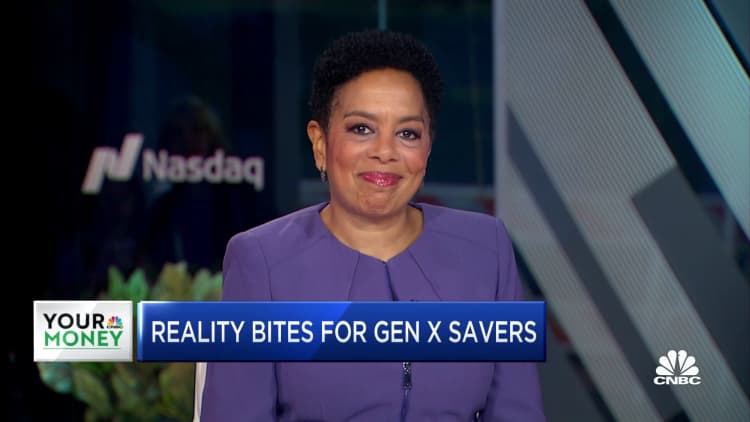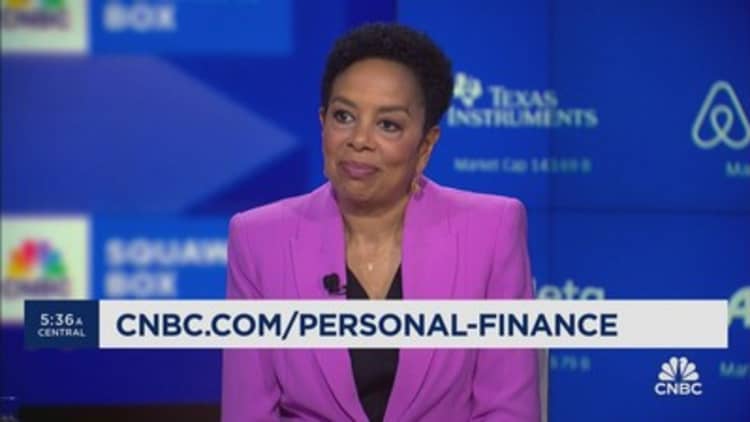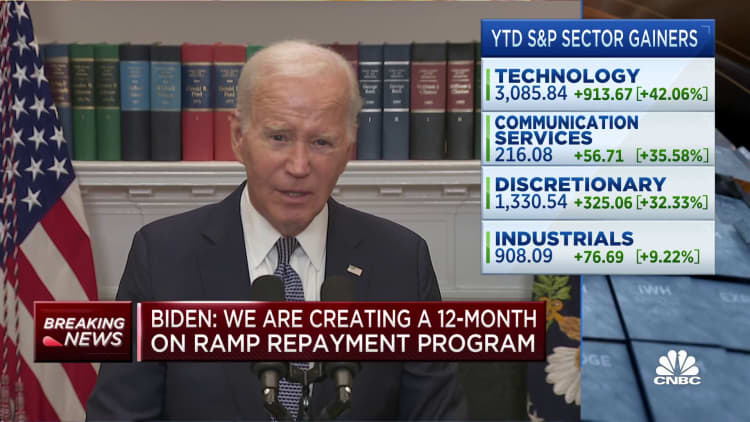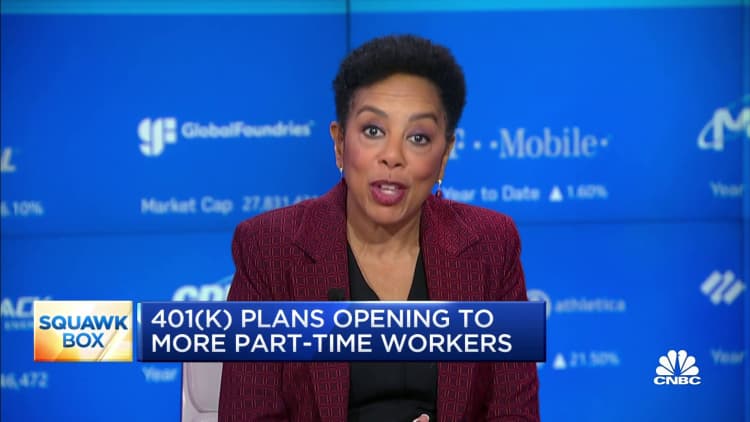Personal Finance
Your financial advisor may not be giving good advice
Published
2 weeks agoon

Ascentxmedia | E+ | Getty Images
Many people claim Social Security retirement benefits at the earliest possible claiming age of 62.
But that decision prompts their monthly benefits to be reduced for the rest of their lives.
Working with a financial advisor should help encourage prospective beneficiaries to understand the value of delaying their benefit claims. Yet recent research finds working with a financial professional does not necessarily encourage individuals to claim Social Security at later ages.
The research — co-authored by David Blanchett, head of retirement research for PGIM DC Solutions, and Jason Fichtner, chief economist at the Bipartisan Policy Center — found the results varied based on advisor type. Higher wealth households tend to claim benefits two years later when working with financial professionals who are paid hourly, such as accountants, compared to households that work with commission-based advisors, or brokers.
Affluent households that work with any type of financial professional, particularly brokers, tend to claim Social Security earlier than those that do not, the research found.
The research concluded that delayed Social Security claiming may not be beneficial for advisors because it reduces client assets they can manage and may make retirement planning less complex.
“This research shows that financial advisors may be biased toward strategies that may provide higher advisor compensation, even if those recommendations are not in the best interests of their clients,” Blanchett and Fichtner wrote.
The research results are “really disappointing,” said Joe Elsasser, a certified financial planner who is president of Covisum, a Social Security-claiming software company.
“I would have at least liked to see a general later [claiming age] trend across all advisors,” Elsasser said.
Why it pays to wait to claim Social Security
When Social Security retirement beneficiaries claim at age 62, their benefits are permanently reduced.
If they wait until their full Social Security claiming age — which is generally between 66 and 67, depending on their year of birth — they may receive 100% of the benefits they’ve earned.
As the Social Security full retirement age moves to age 67, benefits available at age 62 are even further reduced.
By waiting until age 70, retirees stand to receive the biggest benefit boost — a monthly benefit that is 77% higher than what beneficiaries may receive at 62, the research notes.
But delaying until that highest claiming age requires beneficiaries to have other income on which they can rely in the interim. “Delayed claiming isn’t a free lunch,” the research states.

That may mean working longer or bridging to a higher claiming age by turning first to other investments.
Delaying Social Security benefits is so valuable not only because of the increase to benefits, but also the annual cost-of-living adjustments tied to inflation. No annuities on the market provide the same inflation links, the research notes.
To be sure, not everyone can wait to claim until age 70. Those who do delay tend to retire later or have more financial assets, according to the research.
“A lot of Americans don’t have an active choice on when to claim,” Blanchett said.
“If you know that you’re not sick, and you have some money saved for retirement, the odds are you should probably at least delay until 65, 67, maybe 70,” he said.
How to know if you’re getting good claiming advice
Not all financial advisors will have the same knowledge of the ins and outs of Social Security claiming, which comes with a multitude of rules.
Experts say there are signs prospective claimants can watch for to gauge the quality of the guidance they’re getting.
“If a consumer ever gets either a recommendation or an acceptance of an early claim, they’ve got to really evaluate … ‘Why is this advisor giving me that advice?'” Elsasser said.
Try to evaluate your financial professional’s process that led them to that conclusion, he said. Often, it’s a result of longevity assumptions that are too short, or the idea that Social Security benefit income that is claimed early can be invested.
Consumers can gauge longevity estimates using a free online tool, the Actuaries Longevity Illustrator, Elsasser said. Moreover, investment returns that are compared to Social Security should be based on more conservative holdings like government bonds rather than stocks, he said.
More from Personal Finance:
Advice about 401(k) rollovers is poised for a big change. Here’s why
IRS free filing pilot processed more than 140,000 returns, commissioner says
Here’s why new home sales inch higher despite 7% mortgage rates
Written materials provided by the Social Security Administration make it clear that evaluating when to claim is a personal decision, notes Fichtner, who formerly served as acting deputy commissioner at the agency.
A financial professional should also guide you through those same considerations — What is your health status? What other sources of income do you have? How will your claiming decision affect your spouse, if you have one?
Most prospective Social Security claimants are trying to make their money last, rather than maximize their returns, Fichtner said.
Consequently, a financial advisor’s recommendations — whether done independently or through a software — should emphasize protecting lifetime income rather than boosting returns, he said.
Surveys routinely show one of the top reasons Social Security beneficiaries claim early is because they are concerned about the program’s future. The program’s trust funds may run out within the next decade, at which point there may be an across-the-board benefit cut unless Congress acts sooner.
But experts say that’s not a reason to claim early. By delaying, any future prospective cuts would be applied to a higher benefit amount.
Even shorter-term claiming delays of months rather than years can help increase your lifetime income.
“Every month you delay, it’s a benefit increase,” Fichtner said.
Don’t miss these exclusives from CNBC PRO
You may like
Personal Finance
Here are key things to know about company stock, experts say
Published
2 weeks agoon
May 4, 2024
Prasit photo | Moment | Getty Images
As employers compete to attract and retain talent, equity compensation — or an ownership stake in the company — has become a key workplace benefit.
Some 72% of companies offer some form of equity compensation to certain employees, a 2023 survey from Morgan Stanley found. That’s up from 65% in 2021.
These perks motivate employees and boost their long-term investing goals, according to the Morgan Stanley survey, which polled 1,000 U.S. employees and 600 human resource executives.
However, some “miss the opportunity” because they don’t understand it, said certified financial planner Chelsea Ransom-Cooper, chief financial planning officer for Zenith Wealth Partners in New York.
More from Personal Finance:
This job perk is like a ‘cash bonus’ — but you need a long-term strategy, experts say
Employee stock purchase plans offer ‘free money’ — but also carry complexity and risk
Treasury Department announces new Series I bond rate of 4.28% for the next six months
Here’s what to know about three popular types of stock-based compensation, experts say.
There’s potential for ‘life-changing wealth’
Many employees receive so-called stock options as part of their compensation, which are the right to buy or “exercise” company shares at a preset price within a specific timeframe.
“It’s almost iconic to grant stock options in a startup private company,” said Bruce Brumberg, editor-in-chief and co-founder of myStockOptions.com, which covers various types of equity compensation.
Startups want to create the drive and incentive of ownership culture with the potential for “life-changing wealth,” he said.
Stock options become valuable when there’s a discount between your preset price and the market value, which makes it more attractive to exercise. However, the taxes can be complicated, depending on the type of stock options.
Incentive stock options can offer some tax benefits — if you meet certain rules — but could trigger the alternative minimum tax, a parallel system for higher earners.
Photo by LanaStock via Getty Images
By comparison, the more common nonqualified stock options generally have less favorable tax treatment and you’ll owe regular income taxes on the discount upon exercise.
But even with an initial discount, there’s no guarantee a company’s stock price won’t decrease after exercising a stock option.
“It could be worth nothing but a piece of paper,” Ransom-Cooper from Zenith Wealth Partners said.
Restricted stock units are ‘like a cash bonus’
Another benefit, restricted stock units, or RSUs, are company shares granted upon hiring, which vest over time. RSUs can also be tied to performance-based goals.
Some 94% of public companies offer RSUs to at least middle managers, according to a 2021 survey from the National Association of Stock Plan Professionals.
“I like to think of it like a cash bonus,” said Pittsburgh-based CFP Matthew Garasic, founder of Unrivaled Wealth Management.
I like to think of it like a cash bonus.
Matthew Garasic
Founder of Unrivaled Wealth Management
For example, if the stock price is $10 and 100 shares vest, it’s treated like $1,000 in compensation for that year, and the standard withholding of 22% might not be enough, depending on your tax bracket, he explained.
After vesting, the decision to sell or hold RSUs depends on your short- and long-term investing goals.
“We like to establish a target of what they like to hold in company stock,” said Garasic, who aims to keep allocations of a single stock to 10% or less. “Once we get above that target, we just sell at vest.”
Employee stock purchase plans offer ‘free money’
Many publicly traded companies may also offer discounted company shares via an employee stock purchase plan, or ESPP.
“There’s free money to be had” with an ESPP, Garasic explained.
However, the decision to participate typically depends on your short-term financial goals.
After enrolling, your ESPP collects a portion of after-tax money from each paycheck and uses the funds to buy discounted company stock on a specific date.
The gold standard is a 15% discount with a lookback feature, which bases the stock purchase price on the value at the beginning or end of the offering period, whichever is lower, experts say.
Any time you’re investing in a single company, there’s certainly a big risk.
Kristin McKenna
President of Darrow Wealth Management
You can typically sell after a set period, but there’s no guarantee you’ll make money, even with the built-in discount.
“Any time you’re investing in a single company, there’s certainly a big risk,” CFP Kristin McKenna, president of Darrow Wealth Management in Boston, previously told CNBC.
Yearly goals like investing up to your employer’s 401(k) match should come before your ESPP, especially with limited income, she added.

Personal Finance
Public Service Loan Forgiveness program will go on partial pause
Published
2 weeks agoon
May 3, 2024
Teacher teaching her students in art class at school.
Fg Trade | E+ | Getty Images
The popular Public Service Loan Forgiveness program began a partial processing pause on May 1, which will likely run through July, the U.S. Department of Education recently said.
The temporary suspension comes as the Biden administration overhauls the once-troubled federal student loan program.
Here’s what borrowers should know.
Why the pause is happening
The PSLF program, signed into law by President George W. Bush in 2007, allows certain not-for-profit and government employees to have their federal student loans canceled after 10 years of on-time payments.
However, the program has been plagued by problems, making people who actually get the relief a rarity.
Borrowers often believe they’re paying their way to loan cancellation only to discover at some point in the process that they don’t qualify, usually for confusing technical reasons. Lenders have been blamed for misleading borrowers and botching their timelines.
More from Personal Finance:
Advice about 401(k) rollovers is poised for a big change. Here’s why
IRS free filing pilot processed more than 140,000 returns, commissioner says
Here’s why new home sales inch higher despite 7% mortgage rates
The Biden administration has been trying to reform the program. As part of that overhaul, it is changing how loan servicing works for public servants, and some of the customer service will soon be handled by the government itself.
“After the improvements, PSLF borrowers will have all of their PSLF information centralized on StudentAid.gov so that the Department can provide real-time and more accurate information on payment counts and form processing,” the Education Department wrote in a recent blog post.
Previously, only one company managed the servicing for PSLF borrowers on behalf of the government: first, FedLoan, and more recently, Mohela, or the Missouri Higher Education Loan Authority. Going forward, a number of different companies will service the accounts, along with the Education Department.
What borrowers can expect during the transition
The Education Department will not review PSLF form submissions for roughly a two-month period, it says. (The exact dates will depend on how long the changes take place to complete.)
Meanwhile, from May 1 through July, it says, “borrowers will not be able to see their PSLF payment counts on MOHELA’s website.”
“During the transition, PSLF forgiveness will be suspended,” said higher education expert Mark Kantrowitz.

Borrowers will be able to continue making their loan payments, and these months will count on their timeline to loan forgiveness. Borrowers should also be able to submit a form to certify public service employment and to apply for loan forgiveness if they are at the 10-year mark.
“Forms will be reviewed as soon as the transition is complete,” the Education Department says.
If you qualify for debt cancellation during the transition, you can request a forbearance from your servicer in the meantime, it says, adding that any overpayments should be refunded.
Don’t miss these exclusives from CNBC PRO
Personal Finance
Your Roth 401(k) after-tax matching contribution could trigger taxes
Published
2 weeks agoon
May 3, 2024
If you’ve opted into your employer’s Roth 401(k) after-tax matching contributions this year, it could trigger a tax surprise without proper planning, experts say.
Enacted in 2022, Secure 2.0 ushered in sweeping changes for retirement savers, including the option for employers to offer 401(k) matches in Roth accounts. These accounts are after-tax, meaning employees pay upfront taxes but growth and withdrawals in retirement are tax-free. Previously Roth 401(k) matches went into pretax accounts.
Roughly 12% of employers with 401(k) plans said they are “definitely” adding the feature and 37% are “still considering it,” according to a recent survey from the Plan Sponsor Council of America.
However, those new matching Roth contributions could have “unintended consequences” at tax time, according to Tommy Lucas, a certified financial planner and enrolled agent at Moisand Fitzgerald Tamayo in Orlando, Florida.
More from Personal Finance:
IRS aims to more than double its audit rate on wealthiest taxpayers
Here are three ways to lower your credit card annual percentage rate, experts say
Why your financial advisor may not give you the best Social Security advice
“If you go this route, you’ll want to know that you’re basically getting extra income” and taxes aren’t automatically withheld, Lucas said.
“You’re increasing your adjusted gross income by taking this match as a Roth,” he said.
“If you go this route, you’ll want to know that you’re basically getting extra income.”
Tommy Lucas
Financial advisor at Moisand Fitzgerald Tamayo
For example, let’s say your salary is $100,000 with a 6% employer match in 2024. If you designate your $6,000 employer match as Roth and you’re in the 22% federal income tax bracket, you could have an extra $1,320 in tax liability, according to Lucas.
“There’s probably something on top of that for state income taxes,” depending on where you live, he said.
Plus, you won’t see your employer’s matching Roth contribution reported on Form W-2, according to IRS guidance released late last year. Instead, you’ll receive Form 1099-R, which could be confusing, Lucas said.
How to plan for income from Roth 401(k) matches
If you’ve chosen your company’s Roth matches for 2024, you need to prepare for the extra income, said CFP Jim Guarino, managing director at Baker Newman Noyes in Woburn, Massachusetts. He is also a certified public accountant.
You can increase your federal and state withholdings with your employer or boost your quarterly estimated tax payments, he said.

For example, if you expect to incur $1,320 more in federal taxes, you could divide that amount by your remaining 2024 paychecks and include that “extra withholding” on Form W-4 for your employer, Lucas said.
Of course, you’ll need to double-check that the change is reflected on future paychecks, he said.
“In either case, working with a trusted tax advisor would help to optimize overall tax planning and eventual tax reporting for the year,” Guarino added.
Don’t miss these exclusives from CNBC PRO

Betting on the Kentucky Derby? Here’s how to think like a professional handicapper.

Warren Buffett says Greg Abel will make Berkshire Hathaway investing decisions when he’s gone

EV makers win 2-year extension to qualify for tax credits

Are American progressives making themselves sad?

‘Best Firms for Tech’ 2024 deadline extended to April 10

